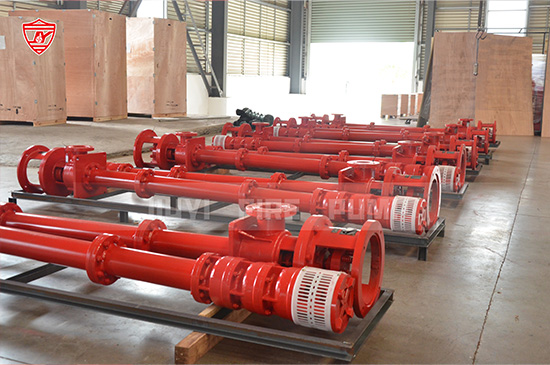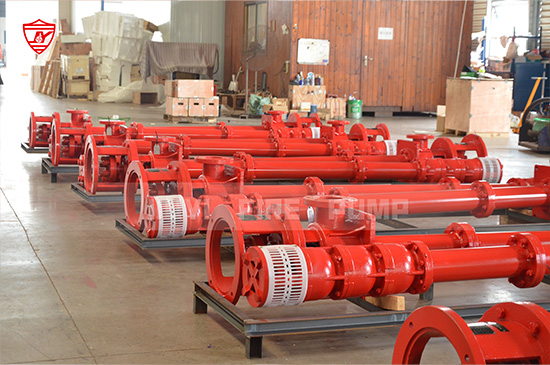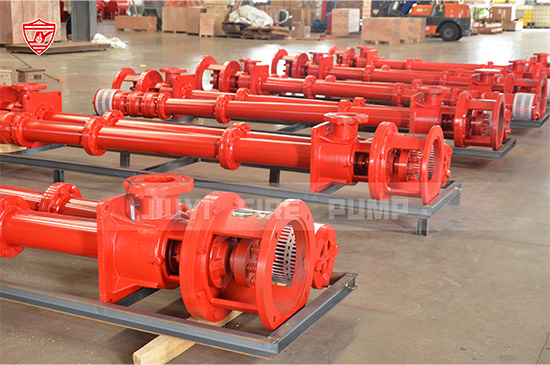Vertical turbine fire pumps play a critical role in ensuring reliable water supply for fire protection systems in high-rise buildings, industrial facilities, refineries, and municipal infrastructures. These pumps are designed to deliver high volumes of water under extreme conditions, making their efficiency and reliability crucial for life safety.
However, one of the most common and damaging problems faced by vertical turbine fire pumps is cavitation. Cavitation occurs when vapor bubbles form inside the pump due to low pressure, then collapse violently when they reach higher-pressure zones. This phenomenon can cause severe damage to pump components, reduce efficiency, and even lead to catastrophic pump failure.
In this article, we’ll explain what cavitation is, why it happens, how it affects vertical turbine fire pumps, and — most importantly — how to prevent cavitation effectively. By following proper design, installation, and maintenance practices, you can protect your fire pump systems and ensure long-term performance.

Cavitation is a hydraulic issue caused by the formation of vapor bubbles when the pressure inside the pump drops below the liquid’s vapor pressure. As the impeller moves the water, these bubbles collapse violently in high-pressure areas, causing shock waves that erode pump surfaces and reduce efficiency.
In vertical turbine fire pumps, cavitation is particularly critical because these pumps often operate in applications requiring high suction lifts, deep well installations, or variable water levels. If cavitation is not addressed, it can cause:
Severe impeller and bowl assembly damage
Increased vibration and noise
Reduced water flow and pressure
Shortened pump lifespan
Fire protection system performance failures
Several factors contribute to cavitation in vertical turbine fire pumps. Understanding these causes is the first step toward prevention:
If the NPSH available is lower than the NPSH required by the pump, vapor bubbles form and cavitation occurs.
Causes include improper pump selection, incorrect sump design, or low water levels.
Poorly designed sumps cause uneven water flow and air entrainment, which increase the risk of cavitation.
NFPA 20 and Hydraulic Institute guidelines provide recommended dimensions to minimize vortexing and turbulence.
Operating pumps at higher-than-rated speeds can reduce suction pressure and increase cavitation risks.
Blockages or undersized strainers can restrict water entry into the pump, lowering inlet pressure and increasing cavitation probability.
Elevated water temperatures lower the liquid’s vapor pressure, making cavitation more likely, especially in industrial applications.
Early detection is crucial to minimize damage and costly downtime. Look out for these warning signs:
Unusual Pump Noise: A “gravel” or “rumbling” sound inside the pump bowl or column pipe.
Excessive Vibration: Increased vibrations due to collapsing vapor bubbles damaging impellers.
Performance Drop: Decrease in discharge pressure and water flow capacity.
Physical Damage: Pitting or erosion on the impeller, suction bell, or bowl assembly during inspection.
Rising Motor Load: Cavitation can cause increased torque and higher energy consumption.

Preventing cavitation involves a combination of proper system design, correct pump selection, and regular maintenance. Below are key strategies to protect your vertical turbine fire pumps:
Verify that NPSH available (NPSHa) exceeds NPSH required (NPSHr) by the pump, with a sufficient safety margin.
This can be achieved by:
Lowering the pump setting deeper into the water source.
Ensuring proper sizing of the suction pipe or column.
Minimizing friction losses in suction piping.
NFPA 20 specifies proper installation standards for vertical turbine fire pumps, including sump dimensions, submergence depth, and suction inlet conditions.
Adhering to these standards minimizes vortexing, turbulence, and air entrainment — all key contributors to cavitation.
Maintain adequate submergence depth to avoid vortex formation.
Follow recommended sump design dimensions:
Proper clearance between the pump intake and floor.
Correct spacing between multiple pumps in the same wet well.
Use suction bells designed to reduce turbulence and improve water flow.
Choose a vertical turbine fire pump specifically designed to handle your required capacity, pressure, and suction conditions.
Oversizing or undersizing a pump increases the risk of operating in cavitation-prone regions.
Work with experienced fire pump manufacturers to evaluate your system’s hydraulic requirements accurately.
Always operate the pump within its rated speed range.
Avoid frequent starting and stopping cycles that could affect water levels and suction pressure.
Continuously monitor water source levels, especially in wells, tanks, and reservoirs.
Use level sensors or alarms to prevent pump operation during low-water conditions.
Remove debris, algae, or sediment from the suction bell and strainer to ensure unobstructed water flow.
Use appropriately sized strainers to avoid unnecessary restrictions.
Perform routine vibration analysis, noise monitoring, and hydraulic performance testing.
Regularly inspect the impellers, bowls, and bearings for early signs of cavitation damage.
Keep accurate maintenance records to track performance trends over time.
In fire protection systems, reliable water delivery is critical. Cavitation doesn’t just harm the pump — it threatens the entire fire suppression system’s performance.
Reduced Reliability: A cavitating pump can fail during an emergency, compromising safety.
Increased Costs: Cavitation damage leads to expensive repairs or premature pump replacement.
System Downtime: Prolonged outages while repairing or replacing pumps can leave facilities unprotected.
Compliance Risks: NFPA 20 and local fire safety codes require fully operational fire protection systems at all times.
By preventing cavitation, facility managers can ensure system reliability, meet compliance requirements, and safeguard lives and property.
To keep vertical turbine fire pumps operating efficiently for years:
Select pumps based on accurate hydraulic calculations.
Install pumps according to NFPA 20 and manufacturer guidelines.
Use high-quality materials and components designed for demanding fire protection applications.
Schedule periodic performance testing and preventive maintenance.
Partner with an experienced fire pump manufacturer who can provide technical support and system design expertise.

Cavitation in vertical turbine fire pumps is a serious issue that can lead to costly damage, reduced system performance, and compromised fire safety. By understanding the causes, recognizing the warning signs, and applying effective prevention strategies, facility managers and engineers can ensure reliable pump operation and protect critical fire protection systems.
As a leading manufacturer of vertical turbine fire pumps, we design our products to meet NFPA 20 and UL/FM standards, ensuring high reliability under demanding conditions. Our engineering team provides expert guidance to help you select, install, and maintain fire pumps that deliver consistent performance and long-term durability.
If you’d like professional assistance with selecting or maintaining your vertical turbine fire pump systems, contact us today. We’ll help you keep your fire protection systems operating at peak efficiency.